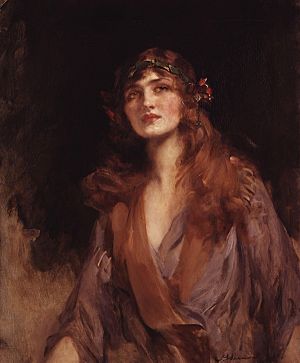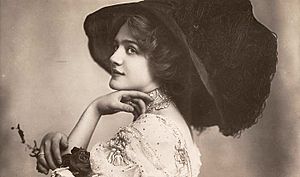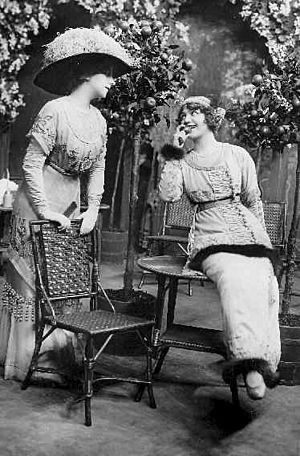Lily Elsie facts for kids
Quick facts for kids
Lily Elsie
|
|
|---|---|

Lily Elsie by James Jebusa Shannon, c. 1916
|
|
| Born |
Elsie Hodder
8 April 1886 Armley, West Yorkshire, England, UK
|
| Died | 16 December 1962 (aged 76) |
| Occupation | Actress, singer |
| Years active | 1895–1929 |
Lily Elsie (born Elsie Hodder, April 8, 1886 – December 16, 1962) was a famous English actress and singer. She was active during the Edwardian era, a time in British history from 1901 to 1910. Lily Elsie became very well known for her main role in the London show The Merry Widow, a popular type of musical play called an operetta.
Lily Elsie started acting as a child in the 1890s. She became famous in many successful musical comedies before her big break in The Merry Widow, which opened in 1907. After that, she starred in more successful operettas and musicals. These included The Dollar Princess (1909), A Waltz Dream (1911), and The Count of Luxembourg (1911). People admired her beauty and charm on stage. She became one of the most photographed women of her time.
Contents
Early Life and Career
Lily Elsie was born in Armley, West Yorkshire, England. Her mother, Charlotte Elizabeth Hodder, was a dressmaker. In 1891, her mother married William Thomas Cotton, who worked in the theatre. After this, Elsie became known as Elsie Cotton. The family lived in Manchester. Lily Elsie was also the niece of Wilfred Cotton, who was married to the actress Ada Reeve.
Becoming a Child Star
Lily Elsie was a talented child performer. She appeared in music hall shows and other variety acts as a child impersonator, known as Little Elsie. Even though she was a star, she was said to be very shy, even as an adult.
By 1895–1896, she performed in concerts and pantomimes in theatres in Salford. In 1896, she played Princess Mirza in a show called The Arabian Nights in Manchester. When she was ten years old, she played the main role in Little Red Riding Hood for six weeks at the same theatre. Then she toured with the show for another six weeks.
Her first performance in London was in 1898. She played Aerielle, the Spirit of the Air, in King Klondike. After this, Elsie toured different parts of England, performing in a play called McKenna's Flirtation for a whole year in 1900. She also appeared in Christmas pantomimes like Dick Whittington (1901) and Blue Beard (1903). She toured in musical comedies such as The Silver Slipper (1901–1902) and Three Little Maids (1903). Around 1900, she started using the stage name Lily Elsie.
Joining George Edwardes' Company
Lily Elsie then joined George Edwardes' theatre company in London. She started as a chorus girl at Daly's Theatre. In 1903, she took over the role of Princess Soo-Soo in the popular musical A Chinese Honeymoon. She then starred in other shows like Madame Sherry and Lady Madcap. In 1904, she played Lady Patricia Vereker in The Cingalee. In 1905, she was Madame du Tertre in The Little Michus. In 1906, she played Lady Agnes Congress in The Little Cherub, Humming Bird in See See, and Lally in The New Aladdin at the Gaiety Theatre. Between 1900 and 1906, she performed in 14 different shows!
The Merry Widow and Major Success
Lily Elsie's biggest success came when she played the main role in the English version of The Merry Widow in London. George Edwardes took Elsie to see the original German show in Berlin. At first, Elsie was not sure about taking the part. She thought her voice might not be strong enough. But Edwardes convinced her. He also took her to meet the famous designer, Lucile, for style advice. Lucile later said that Elsie was beautiful and smart but didn't know how to show her best side.
The show, with English songs by Adrian Ross, opened in June 1907. It ran for an amazing 778 performances at Daly's Theatre. Elsie played the role in London and then toured with the show starting in August 1908. The Merry Widow was a huge hit and made Lily Elsie a major star. One critic praised her on opening night, saying she brought "youthfulness, dainty charm and grace, prettiness and exquisite dancing" to the role. The critic felt she was perfect for the part and had a "genuine triumph."
Lucile designed all of Elsie's costumes for The Merry Widow. This included the famous hats with feathers, which became a huge fashion trend. After this, Lucile often used Elsie to promote her clothing designs. She made Elsie's personal clothes and costumes for other shows. Lucile said that the time when The Merry Widow opened was a very exciting period in London's social life. She added that Lily Elsie was a new actress who made "the whole town raving over her beauty."
Many advertisers wanted to use Lily Elsie's image, and her pictures were popular on postcards. She also received many valuable gifts from admirers. Lucile said that Elsie "was absolutely indifferent to most [men]." Even so, Lily Elsie became one of the most photographed beautiful women of the Edwardian era. An American newspaper, the Atlanta Constitution, wrote in 1915:
"Nature never made a more brilliant success in the beauty business than she did with Lily Elsie.... Everyone agrees that Lily Elsie has the most kissable mouth in all England... she possesses the Cupid's bow outline with the ends curving upward delicately, all ready for smiles.... Strangely enough, the women of the land were among her most devoted admirers."
After The Merry Widow, Elsie appeared in 16 more shows. These included successful English versions of The Dollar Princess in 1909, A Waltz Dream in 1911, and The Count of Luxembourg, also in 1911. She always received great praise. One critic wrote that "it gave great pleasure merely to see her walk across the stage."
Later Career and Personal Life
Lily Elsie left the cast of The Count of Luxembourg to marry Major John Ian Bullough in 1911. He was the son of a rich textile maker. Their marriage was often described as difficult. Elsie also had health problems and several operations during her time on stage. Major Bullough wanted his wife to stop acting. Lily Elsie, who was shy and tired from performing, was happy to leave the stage for several years. She only performed for charity events to help with the war effort.
She returned to acting in 1916 in a play called Malvourneen with Herbert Beerbohm Tree. She also appeared as Lady Catherine Lazenby in The Admirable Crichton in 1916 and in the main role in Pamela in 1917. A magazine called The Tatler wrote that everyone should see Lily Elsie in Malvourneen, saying her acting in comedy was as good as her musical comedy.
In 1920, Elsie moved with her husband to a village in Gloucestershire. She spent ten years away from the stage, enjoying social events and fox hunting. She returned to performing in 1927 in London in The Blue Train. Her last show before retiring was The Truth Game in 1928–1929.
In 1930, Lily Elsie's marriage ended. Her health continued to be a challenge, and she spent much time in special care homes. She passed away at St. Andrew's Hospital in Cricklewood, London, at the age of 76.
Recordings and Films
Lily Elsie made some recordings of songs from her shows. For example, from Pamela, she recorded duets with Owen Nares in 1918, including:
- "I'm so very Glad I met You"
- "It's not the things you've got"
- "I Loved you so"
- "Cupid, Cupid"
From The Blue Train, she recorded songs in 1927, including:
- "The Blue Train"
- "When a Girl is in Love with a Man" (a duet with Arthur Margetson)
- "Eileen" (a duet with Arthur Margetson)
- "Swiss Fairyland"
Lily Elsie also appeared in two films: The Great Love (1918), where she had a small role, and Comradeship (1919).
Images for kids









